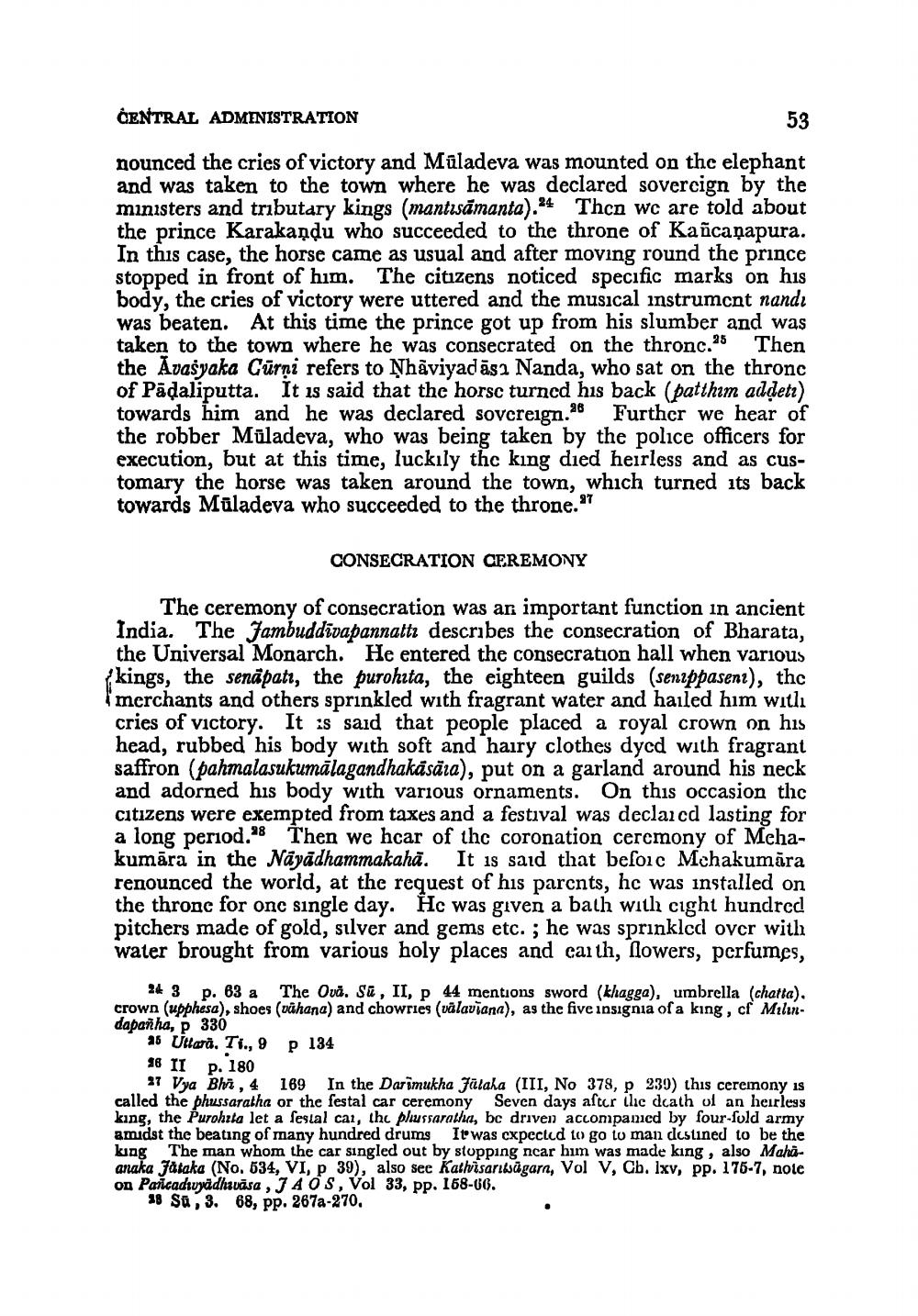________________
CENTRAL ADMINISTRATION
53
nounced the cries of victory and Müladeva was mounted on the elephant and was taken to the town where he was declared sovercign by the ministers and tributary kings (mantisāmanta).24 Then we are told about the prince Karakandu who succeeded to the throne of Kancanapura. In this case, the horse came as usual and after moving round the prince stopped in front of him. The citizens noticed specific marks on his body, the cries of victory were uttered and the musical instrument nandı was beaten. At this time the prince got up from his slumber and was taken to the town where he was consecrated on the thronc.25 Then the Avasyaka Gārņi refers to Ņhàviyadāsı Nanda, who sat on the thronc of Padaliputta. It is said that the horsc turned his back (patthim addet) towards him and he was declared sovereign. Further we hear of the robber Müladeva, who was being taken by the police officers for execution, but at this time, luckily the king died heirless and as customary the horse was taken around the town, which turned its back towards Müladeva who succeeded to the throne.at
CONSECRATION CEREMONY
The ceremony of consecration was an important function in ancient India. The Jambuddivapannattı describes the consecration of Bharata, the Universal Monarch. He entered the consecration hall when various kings, the senāpatr, the purohita, the eighteen guilds (senappaseni), the (merchants and others sprinkled with fragrant water and hailed him witlı cries of victory. It is said that people placed a royal crown on his head, rubbed his body with soft and hairy clothes dyed with fragrant saffron (pahmalasukumālagandhakāsāra), put on a garland around his neck and adorned his body with various ornaments. On this occasion the citizens were exempted from taxes and a festival was declared lasting for a long period. 98 Then we hcar of the coronation ceremony of Mehakumāra in the Nāyādhammakahā. It is said that befoic Mchakumāra renounced the world, at the request of his parents, hc was installed on the throne for one single day. He was given a bath with cight hundred pitchers made of gold, silver and gems etc. ; he was sprinklcd over with water brought from various holy places and caith, flowers, perfumes,
24 3 p. 63 a The Ova. Sa, II, p 44 mentions sword (khagga), umbrella (chatta). crown (upphesa), shoes (vähana) and chowries (vālaviana), as the five insignia of a king, cf Mılındapanha, p 330
16 Uttara. Ti., 9 p 134 16 II p. 180
37 Vya Bhri, 4 169 In the Darimukha Falaha (III, No 378, p 239) this ceremony is called the phussaratha or the festal car ceremony Seven days after clic death of an heirless king, the Purohita let a sesial car, thc plussaratha, bc driven accompanied by four-fuld army amidst the beating of many hundred drums It was cxpected to go to man destined to be the king The man whom the car singled out by stopping ncar him was made king, also Mahaanaka Jataka (No. 534, VI, p 39), also see Kathisarıūgarn, Vol V, Cb. lxv, pp. 175-7, nole on Paticadiyyadhavāsa , JAOS, Vol 33, pp. 168-06.
18 Sü, 3. 68, pp. 2672-270,




